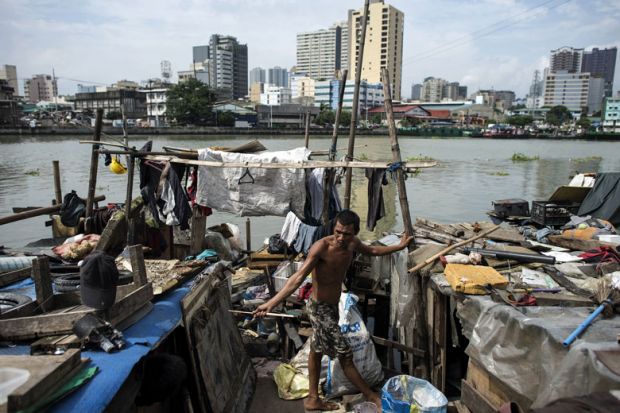Despite efforts to reduce higher education inequality in the Philippines, the divide has grown over the past half-century – with many low-income learners dropping out before obtaining degrees or failing to make it to university at all, a study has found.
Karol Mark Ramirez Yee, faculty member at Ateneo de Manila University’s School of Education and Learning Design, examined data from 1950 to 2015 to establish how social and economic class has affected educational attainment in the country. He found that despite “sustained expansions” of higher education over the six decades, “inequalities widened and persisted at 20 percentage points since the 1980s”.
Government reforms over successive administrations, including the introduction of free secondary education in 1989, have made it easier for those from the lowest income groups to attend university. Yet these changes “did little to alter the trends in college destinations”, with wealthier students still far better represented at “high status” institutions, including a sizeable number of private universities, which are unaffordable to many Filipinos.
Dr Yee, who is also executive director of the Second Congressional Commission on Education – a government body evaluating challenges in the sector – said his study sheds light on when and why students leave education.
“The intention [is] to identify where inequalities emerge…We’re putting our eggs in the HE basket, but unless we ensure completion of secondary education, we’ll never ensure completion of university,” he said.
Many girls quit school because of early pregnancy and marriage, Dr Yee explained. For boys, disengagement was a key factor causing them to drop out, he said, linking their disaffection to a lack of early competency in maths and reading.
“After all, how could you be engaged…if you can’t read or comprehend what you’re studying?” he asked.
According to the study, one of the “critical dropout points” for students is the transition between secondary and tertiary education. Instead of going on to university, many young people went straight to work after high school, seeing this route as more profitable than continuing in education.
While the government has a conditional cash transfer programme meant to cover the opportunity cost of attending university for the “poorest of the poor”, it should also do more to make higher education more enticing, Dr Yee said.
“In a country with finite resources, we have to be clear where we make those strategic interventions.”
Nevertheless, he was upbeat about recent advances meant to widen access to university, saying the “heart was in the right place”. In 2017, two years after the period Dr Yee studied, the government enacted a significant reform, abolishing tuition fees for public universities and colleges to promote universal access.
But there was more room for improvement, Dr Yee said. The government offers low-income students a subsidy of P60,000 (£840) towards tuition fees and living costs, but the money is only enough for a “sub-standard or mid-quality” institution.
“It serves as a glass ceiling…if you want to go to the top universities, there’s no way you could do that,” he said.
What’s more, the subsidy limits low-income students to pursuing lower-cost disciplines, locking them out of more expensive courses such as engineering and medicine, he said.
“Unless we put in immediate measures and access pathways”, he said, the hurdles will inevitably “bar” the poorest students from gaining higher degrees.
Register to continue
Why register?
- Registration is free and only takes a moment
- Once registered, you can read 3 articles a month
- Sign up for our newsletter
Subscribe
Or subscribe for unlimited access to:
- Unlimited access to news, views, insights & reviews
- Digital editions
- Digital access to THE’s university and college rankings analysis
Already registered or a current subscriber? Login








